
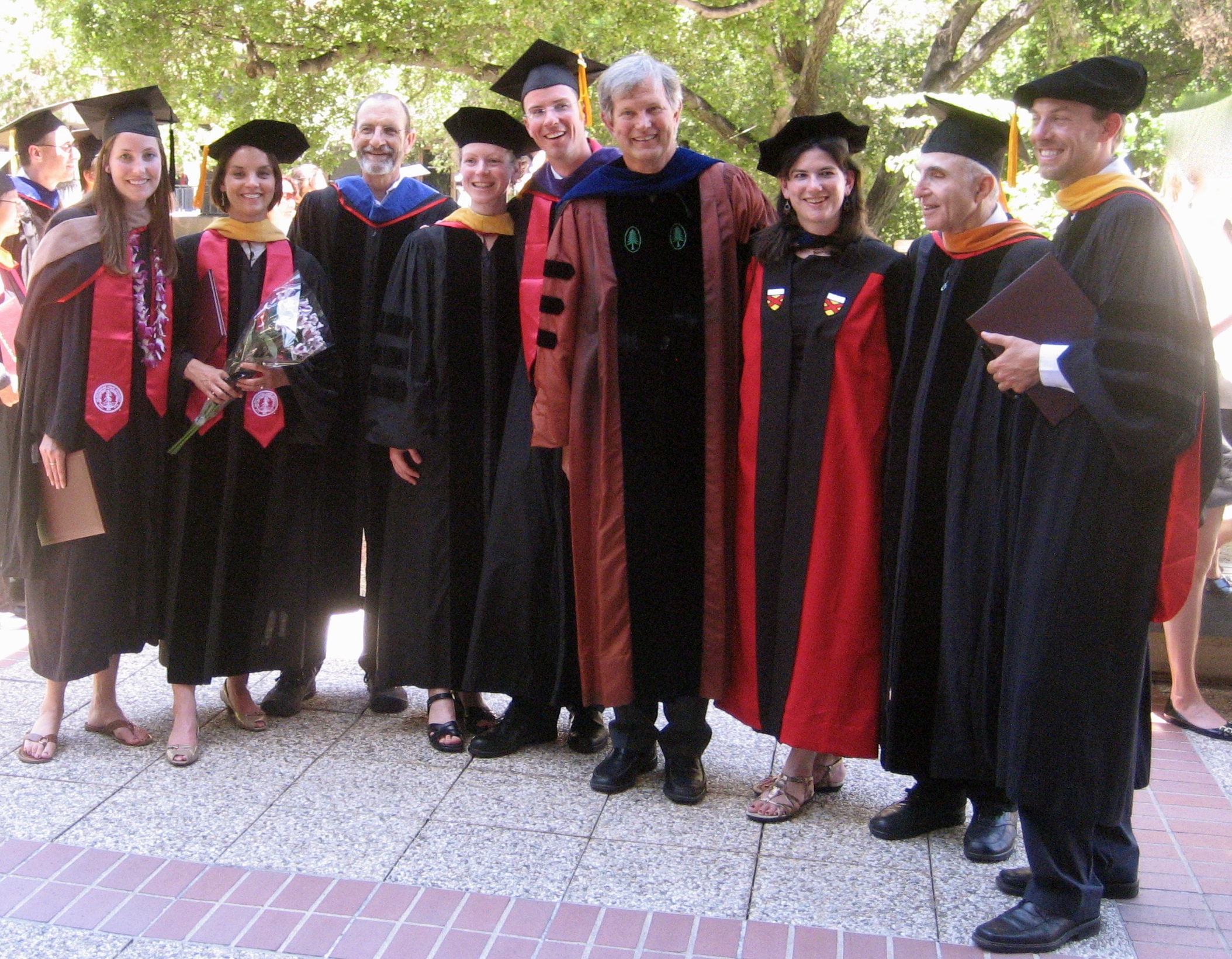
School of Earth Sciences Commencement Ceremony
June 13, 2010.
Congratulations to our graduates!
Pictured from left to right: Annie Hazlehurst (Joint MS-MBA), Hilary Schaffer Boudet (PhD), Chris Field (Carnegie Inst.), Carolyn Snyder (PhD), Jared Thompson (Joint MS-JD), Peter Vitousek (Biology), Kate Brauman (PhD), Len Ortolano (Civil and Environmental Engineering), Michael Hooper (PhD).
Teaching and Committee Service: Nicole Ardoin (Education), Lisa Curran (Anthropology), Jenna Davis (CEE), Gretchen Daily (Biology), Chris Field (Carnegie), David Freyberg (CEE), Mark Jacobson (CEE), Don Kennedy (Woods and Biology), Gil Masters (CEE), Mike Mastrandrea (Carnegie), Steve Palumbi (Hopkins), Erica Plambeck (GSB), Debra Satz (Philosophy), Veena Srinivasan (EESS), Buzz Thompson (Law and Woods), Peter Vitousek (Biology)
Student Leaders: Rachelle Gould, Kristen Honey, Marilyn Cornelius, Valentina Zuin, Robert Heilmayr, Jared Thompson, Annie Hazlehurst, Noa Lincoln, Dane Klinger, Lauren Oakes, Rachael Garrett
Many thanks also to our donors and supporters!
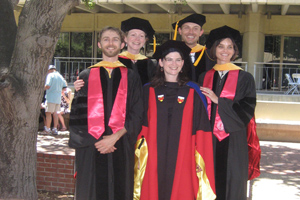 How are native forests on Hawai'i, slum dweller movements in Tanzania, energy installations on the California and Gulf coasts, and climate change over the last million years connected? As subjects of recent E-IPER dissertations, they represent the range of research topics, sites, scales, and theories studied by E-IPER students and interconnect in a number of ways. They look at conflicts or tradeoffs over land use, risk assessment on a global and community scale, social movements, and environmental policies and decision-making processes. These students' thesis research - and their future careers - can potentially influence the long-term health and sustainability of specific communities in the face of increased development pressures and global threats such as climate change.
How are native forests on Hawai'i, slum dweller movements in Tanzania, energy installations on the California and Gulf coasts, and climate change over the last million years connected? As subjects of recent E-IPER dissertations, they represent the range of research topics, sites, scales, and theories studied by E-IPER students and interconnect in a number of ways. They look at conflicts or tradeoffs over land use, risk assessment on a global and community scale, social movements, and environmental policies and decision-making processes. These students' thesis research - and their future careers - can potentially influence the long-term health and sustainability of specific communities in the face of increased development pressures and global threats such as climate change.Michael Hooper's interest in slum dwellers and the international federations that organize and empower the urban poor originated with his work in East Africa with the United Nations Development Program prior to coming to E-IPER. His dissertation research in Dar es Salaam, Tanzania played out in real time as he followed a neighborhood facing a forced eviction to expand a nearby port, studying individual community member's motivations for participation in the Tanzania Federation of the Urban Poor and tracking individuals' post-eviction resettlement success. His findings suggest that policies aimed at addressing the concerns of the urban poor in developing countries should consider a number of social identity and status factors, most importantly property ownership, that influence the dynamics and success of social movements.
Starting in September, Mike will be an assistant professor of Urban Planning at Harvard University's Graduate School of Design in Cambridge, MA.
Hilary Schaffer Boudet also studied social movements and community mobilization, focusing her work on the siting of liquid natural gas termini, one of many so-called "locally unwanted land uses" which include hazardous waste facilities, landfills, prisons, and power plants. Studying two coastal California communities in depth and following with a broader study of sites on the Gulf and North Atlantic coasts, Hilary found that a number of local social and political factors influence the success of a siting proposal, including the perceived threat of the facility on the community, the community's political influence, and the resources the community can direct toward mobilizing against the proposal. Hilary's work provides important insights for researchers on facility siting and for planners embroiled in such conflicts, in terms of key policy levers affecting mobilization outcomes.
Hilary will be a postdoctoral scholar with Tom Robinson in Stanford's Department of Medicine/Stanford Prevention Research Center to develop and evaluate a community-based intervention to increase energy efficiency behaviors among children and families, starting this summer.
Kate Brauman focused her fieldwork on several upland sites in Kona, Hawai'i, comparing the effects of native forests with pasture on available water resources. After collecting biophysical data for over a year at several sites, Kate concluded that native forests are able to capture significant quantities of cloud water and thus replenish groundwater resources, which directly benefits the populated coastal communities. She builds the case that upstream landowners could be paid to preserve or restore native forests on their land to provide a valuable ecosystem service – increased groundwater resources – to the downstream community, a positive outcome for the landowners, the coastal residents, and the native forests.
Kate will be a postdoctoral fellow at the University of Minnesota's Institute on the Environment working in collaboration with Global Landscapes Initiative (GLI) research team to develop new approaches to the study of land use, agriculture and water resources at regional and global scales.
Carolyn Snyder's research looked at nearly a million years through the Earth's climate history to help us understand how the Earth might respond to the increases in atmospheric greenhouse gases projected by studies such as those of the Intergovernmental Panel on Climate Change. Her analysis suggests that the Earth's climate may be more sensitive to increasing greenhouse gas concentrations than predicted, resulting in potentially larger temperature increases and higher risks of climate change than previously published. She believes most current policies are conservative in their anticipation of climate change impacts and hopes her work will influence future climate policies to take into account the increased climate sensitivity she has calculated.
Carolyn has been appointed Director for Clean Energy and Climate Policy in the State of Delaware's Department of Natural Resources and Environmental Control, starting in July.
Watch all the dissertation presentations online.
 This Spring E-IPER is graduating its third cohort of Joint Masters of Science students, sending three Joint MS-JD and six Joint MS-MBA students on to a number of influential, environmentally relevant positions in non-profit organizations, law firms, and clean energy business and investing.
This Spring E-IPER is graduating its third cohort of Joint Masters of Science students, sending three Joint MS-JD and six Joint MS-MBA students on to a number of influential, environmentally relevant positions in non-profit organizations, law firms, and clean energy business and investing.We sat down with a handful of these students to discuss their E-IPER experience and its influence on their career choices. Their paths were as varied as the students themselves, but everyone noted that E-IPER's flexible structure that allows each student to chart his or her own unique path is one of the great hallmarks of the program.
For Michael Dawson, who will be the director of business development for the energy efficiency company OPOWER, having the E-IPER Joint MS on his resume was key to receiving that job offer, as E-IPER allowed him to show "the cleantech start-up community his seriousness about being a leader in that industry." Michael noted that "for a student interested in cleantech, E-IPER's Joint MS is the only program covering solar technology, carbon sequestration, and smart grid, courses which are offered in several different departments on campus."
Tom Mercer, currently a research project manager with Stanford's Program on Water in the West, jointly led by the Bill Lane Center for the American West and the Woods Institute for the Environment, agreed with Michael about the professional value of the Joint MS degree. Tom particularly appreciated the opportunity to explore a number of different interests in the environmental realm: from an initial interest in corporate sustainability strategy, to a collaboration with E-IPER PhD student Marilyn Cornelius on behavior change and residential energy efficiency, to his current work on water resources in the western US.
Jared Thompson will begin his legal career with Hogan Lovells, a Washington DC-based law firm, but first he will spend a year working for the Natural Resources Defense Council on a fellowship focused on climate change and water resources that Jared credits, in part, to his E-IPER Joint MS coursework. He also appreciated E-IPER's "wonderfully enriching intellectual experience" and the opportunity to build a professional network wider than the law school through his participation in the E-IPER community.
Greg Wannier, who will be a fellow at Columbia University's Center for Climate Change Law next year, echoed that the Joint MS sends an important message to potential employers, "It shows that I have gone out of my way to understand the complex systems the law intends to regulate." Through his E-IPER coursework Greg gained an overview of the science underlying energy systems and climate change, noting several classes that should be required for anyone interested in practicing energy law.
E-IPER's graduating Joint MS students will head out into world armed with a unique interdisciplinary environmental science and technology background that, combined with their professional degrees, will allow them to be environmental leaders and change agents in tackling the complex problems currently facing the planet.
Learn more about E-IPER's alumni on our web site.
Image credit: Adelie Penguin (Pygoscelis adeliae), Vega Island, Weddell Sea, Antarctica, Jan. 2009, copyright Robert B. Dunbar.
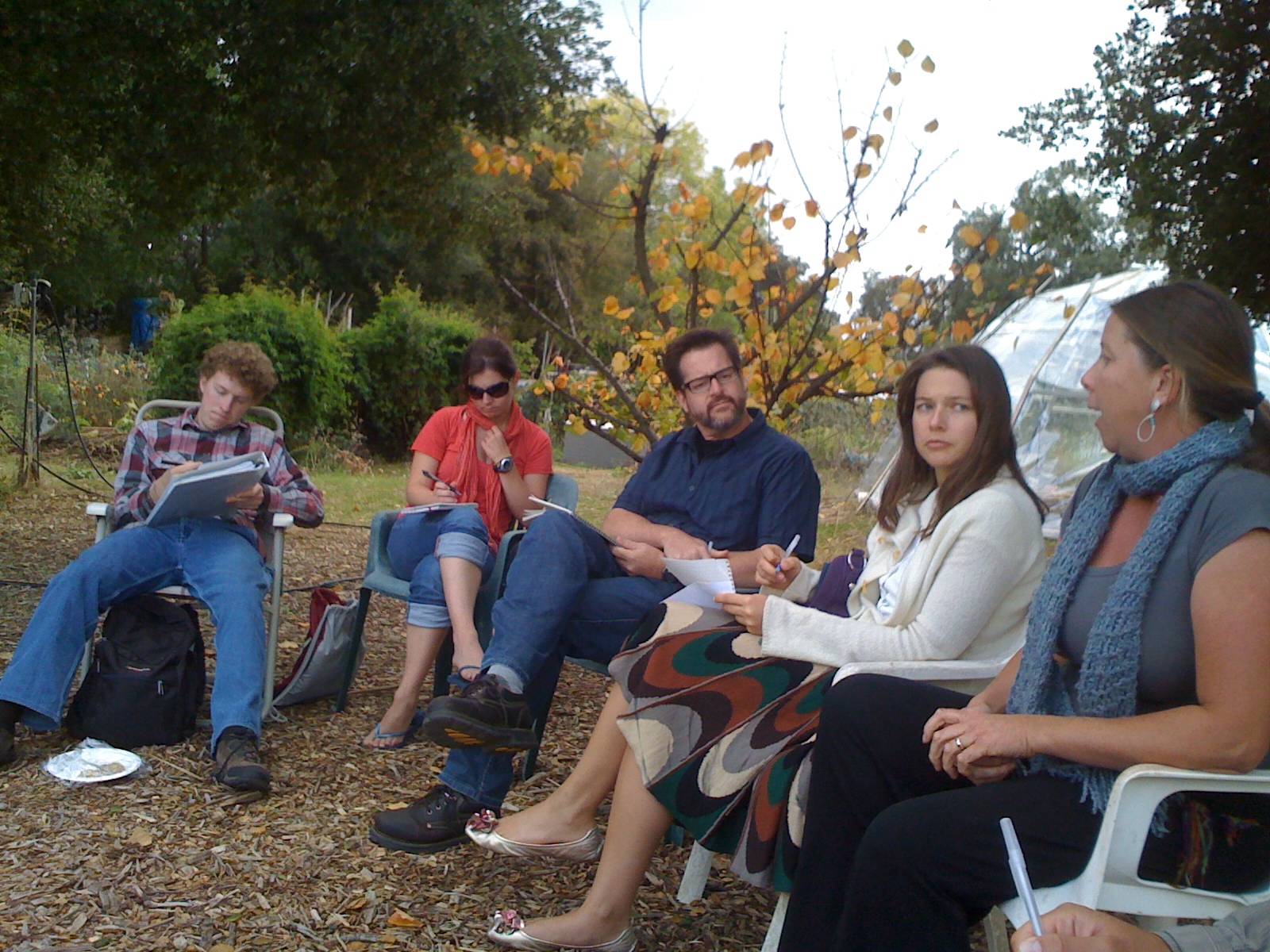 Why can't we install windmills in our backyards and trap the energy for personal use? Is it better to eat with wooden chopsticks or disposable forks? Can Styrofoam be recycled? Or even, more starkly, are we all doomed?
Why can't we install windmills in our backyards and trap the energy for personal use? Is it better to eat with wooden chopsticks or disposable forks? Can Styrofoam be recycled? Or even, more starkly, are we all doomed? Under the guidance of science journalist and E-IPER lecturer Thomas Hayden, Stanford students tackle these questions and more in the course Sustaining Action: Research, Analysis and Writing for the Public. The class, offered twice a year since Winter 2009, attracts both undergraduate and graduate students from an array of academic disciplines, united by a shared desire to assess and communicate the science of environmental sustainability in an accurate and broadly accessible manner.
So far, Hayden has received more than 500 questions about environmental issues and sustainable living from Stanford alumni, and he matches each student with three according to their background and interests. Students research the answers throughout the quarter, and craft engaging, informative responses that emulate the style of well-known advice columns, but are delivered with technical understanding and scientific rigor. According to Earth Systems undergraduate Lauren Kubiak, "We get a seemingly simple question, and then three hours, seemingly endless research and many quantitative calculations later, it seems like I'm answering the most complicated question in the world, especially when trying to package it into an accessible 500-word answer."
Every month, STANFORD magazine publishes two of these "eco-advice" columns on its website. Hayden's inaugural winter 2009 class dubbed the column "SAGE"- Sound Advice for a Green Earth. SAGE celebrated its one-year anniversary of regular publication in May with support from the School of Earth Sciences, the Woods Institute for the Environment, and the Office of the President.
To read the SAGE column and submit your own questions visit the SAGE website.
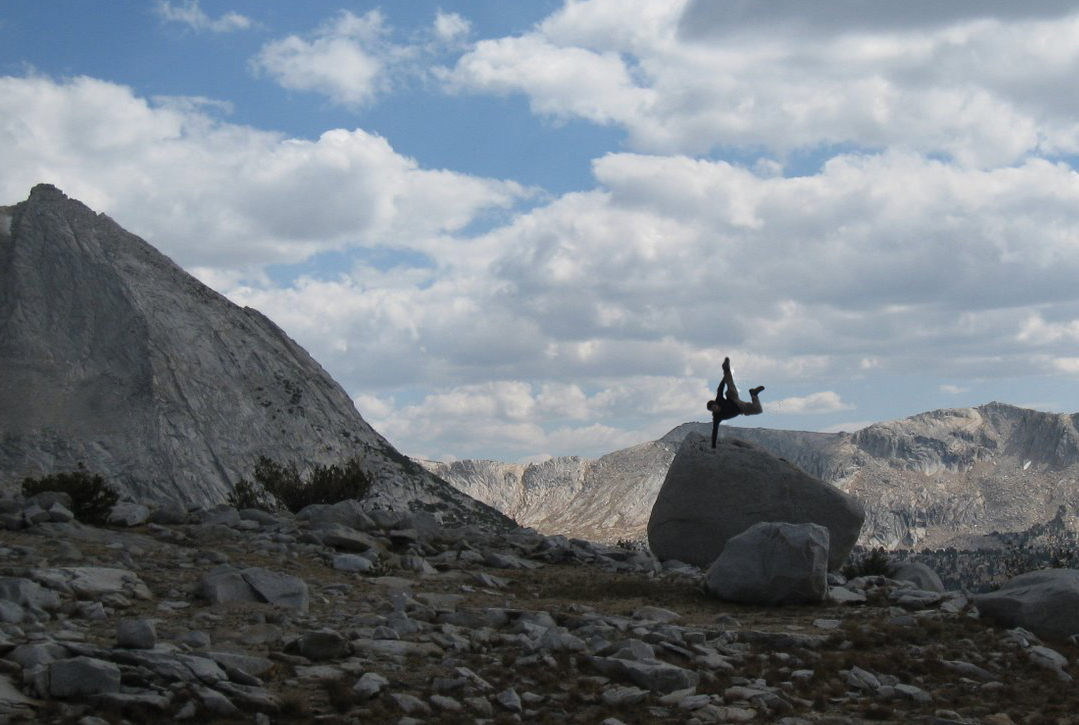 The tragic oil spill in the Gulf of Mexico and recent deadly coal mine and natural gas pipeline explosions should force each of us to consider the very real environmental and human dangers created by our energy consumption. As a society, we are poised at a pivotal point at which new energy technologies are rapidly advancing, public awareness and concern about energy are heightened, and political will is beginning to shift towards actions and policies that may lead toward a more sustainable energy future.
The tragic oil spill in the Gulf of Mexico and recent deadly coal mine and natural gas pipeline explosions should force each of us to consider the very real environmental and human dangers created by our energy consumption. As a society, we are poised at a pivotal point at which new energy technologies are rapidly advancing, public awareness and concern about energy are heightened, and political will is beginning to shift towards actions and policies that may lead toward a more sustainable energy future.It is no surprise, then, that E-IPER's Joint MS students from the Graduate School of Business are seeking opportunities where they can have an impact in the emerging clean energy sector. Renewable portfolio standards, energy storage, peak power, and smart grids and meters are topics in which E-IPER students are focusing their academic work and represent business opportunities where graduates are finding exciting positions.
This Spring the first group of students completed their Capstone Projects, a new requirement for the Joint MS degree through which students demonstrate how they have integrated their professional school training with the science, engineering, and technology they have learned through the Joint MS. By design, the Capstone Project gives students flexibility to work on a project that may help launch their career and produce a product such as a business plan or market analysis that they can highlight in their job search. Students may consult with faculty and other students or collaborate with an outside client.
For their Spring quarter projects, five Joint MS-MBA students took on several challenges within the clean energy sector. For his project with Primus Power, Understanding Utility Requirements for Grid-Scale Batteries, Michael Dawson identified utility needs and market opportunities to address the intermittency problem posed by renewables – that is, loss of power generation when the wind dies or the sun is obscured – by improving the capacity and efficiency of energy storage systems. Mike Dorsey and Brenden Millstein's project, Carbon Lighthouse, Leading the Way to a Carbon-Free Future, developed a start-up business to capitalize on the opportunity to enable corporations to reduce their carbon footprint and still remain profitable via a "one-stop" engineering and financing consultancy. For her project, Opportunities in Energy Efficiency, Sumi Kim also looked at business opportunities in energy efficiency and financing, focusing on the residential sector and retrofit financing incentives created by the new Property Assessed Clean Energy (PACE) policies being implemented in some communities. Finally, working with Joby Energy on her project Business Opportunities for Joby Energy, High Altitude Wind, Sandrine Dury analyzed the opportunity for tethered wind turbines that fly more than 1,000 feet up - to contribute a less intermittent, higher capacity, and lower cost renewable energy supply to existing energy sources.
The students presented their projects to the E-IPER community at a symposium on June 1, 2010 Whether or nor these intriguing projects grow into successful ventures, they clearly demonstrate the role that science, engineering, and technology can and should have in the emerging clean energy economy.
Image credit: Brenden Millstein, Founder/CEO of Carbon Lighthouse
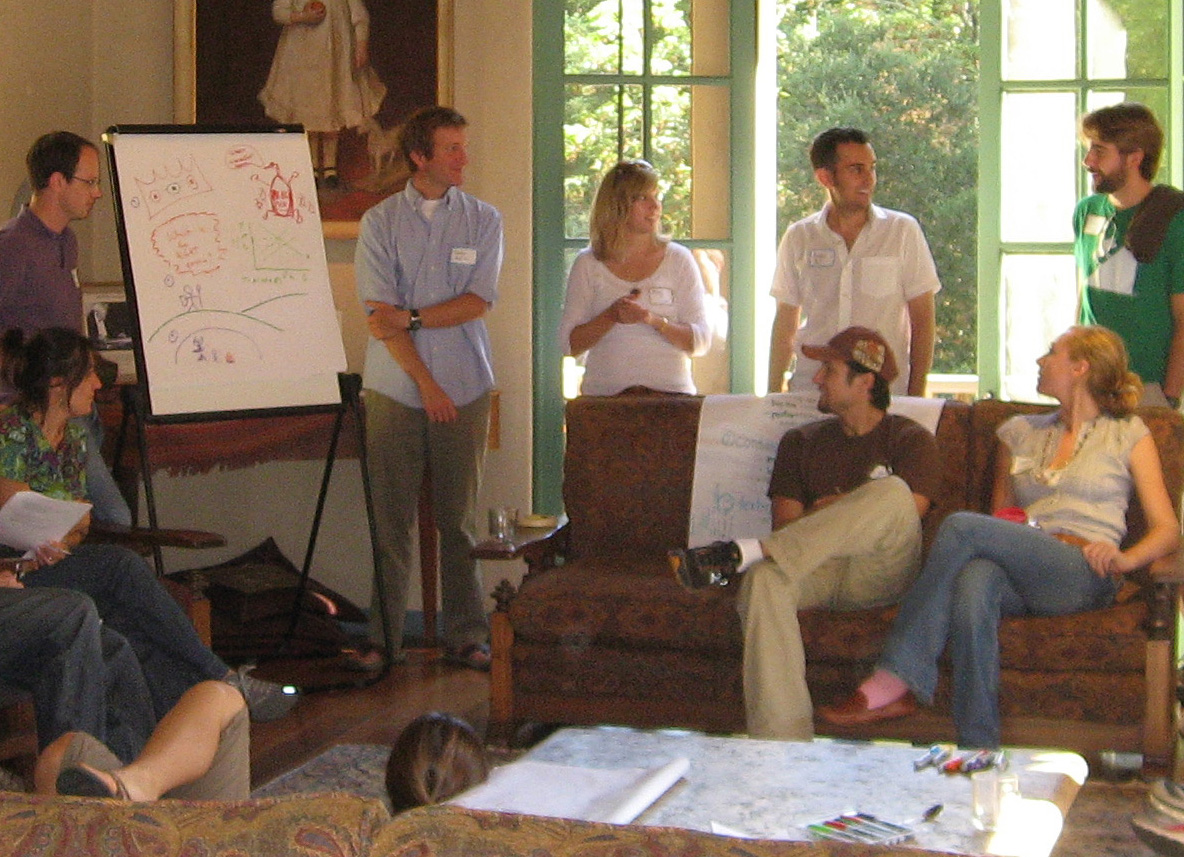 On the conference circuit, through publications, awards and fellowships, in courses and workshops, E-IPER students and faculty make an impact.
On the conference circuit, through publications, awards and fellowships, in courses and workshops, E-IPER students and faculty make an impact.Awards and Fellowships
Peter Vitousek (E-IPER faculty director, Clifford G. Morrison Professor in Population and Resource Studies, Biology) was awarded the 2010 Japan Prize for his pioneering work in the field of biogeochemistry. In April Peter received the prize at the Science and Technology Foundation of Japan in the presence of the Emperor of Japan. Read more...
Austin Becker (2nd year PhD) was awarded 2nd place in the student presentation competition for his presentation, Climate Change Impacts on Ports: A Global Survey Preliminary Results, at the American Society of Civil Engineers Ports 2010 Conference in Jacksonville, FL.
Michael Dawson (Joint MS-MBA '10) was awarded the Feigenbaum Nii Prize for his Spring quarter Capstone Project, Understanding Utility Requirements for Grid-Scale Batteries.
Narasimha Rao (4th year PhD) won the Centennial Teaching Assistant award for his work with Debra Satz (Philosophy) and Steve Schneider (Biology and Woods) on a new course offered this spring, Ethics and Environmental Choices.
Marilyn Cornelius and Rachelle Gould (3rd year PhD) were each awarded a three-year Stanford Interdisciplinary Graduate Fellowship for their work on energy efficiency and behavior change and on forest restoration and cultural ecosystem services, respectively.
Noa Lincoln (2nd year PhD) received a three-year National Science Foundation (NSF) Graduate Research Fellowship for his work on modern and indigenous agricultural practices in Hawai'i. Noa was also a finalist for the Switzer Environmental Fellowship.
Adam Millard-Ball (4th year PhD) was awarded an Eisenhower Graduate Fellowship from the US Department of Transportation to support his work on local climate planning and the impact of carbon trading programs on the transportation sector.
Andrew Perlstein (5th year PhD) received a one-year fellowship from the Freeman Spogli Institute's China Fund for his research on urbanization, land-use policy, and urban planning practices in China.
Nicola Ullibari, incoming PhD student, was awarded both the NSF Graduate Research Fellowship and the Stanford Graduate Fellowship in Science and Engineering (SGF). Incoming student Greg Bratman also holds the SGF and incoming student Frances Moore will continue her NSF Graduate Research Fellowship.
Publications
Austin Becker (2nd year PhD): Ready Whatever the Weather, Ports and Harbors. March 2010, Vol 55 No 2.
Hilary Schaffer Boudet (PhD '10) and Len Ortolano. A tale of two sitings: Contentious politics in liquefied natural gas facility siting in California. Journal of Planning Education and Research, in press.
Dane Klinger (2nd year PhD): Sustainability and Global Seafood, Science Magazine, Vol. 327. no. 5967, pp. 784 - 786, DOI: 10.1126/science.1185345.
Amy Pickering (3rd year PhD), Jennifer Davis, Alexandra Boehm, et al: Hands, Water, and Health: Fecal Contamination in Tanzanian Communities with Improved, Non-Networked Water Supplies. Environmental Science & Technology, 2010; 44 (9): 3267 (10.1021/es903524m; Press Release.
Conference Posters and Presentations
Rachael Garret (2nd year PhD): A Spatially Explicit Macroeconomic Model of Soybean Expansion in Brazil, in the Drivers and Impacts of Agricultural Land Use Change session at the Annual Association of American Geographers meeting, Washington DC, April 2010.
Jason Kaminsky (GSB '08, E-IPER '09): Enhancing Water and Energy Resources: Capping Reservoirs with PV Solar Energy Systems, at the Photovoltaics Summit in San Diego in May. Jason, who is Strategic Assistant to the CEO at SPG Solar, also introduced their new "Floatovoltaics" product.
Adam Millard-Ball (4th year PhD): Reducing Transportation Emissions in the Developing World: The Promise and Perils of Carbon Trading, at a UC-Davis Institute for Transportation Studies seminar. Adam also presented his work at a UCLA symposium, Measuring Progress Towards Transportation Greenhouse Gas Goals.
Lauren Oakes (1st year PhD): To Think, To Write, To Publish workshop, Consortium for Science Policy & Outcomes, Arizona State University, in May in Tempe, AZ; also participated in the NSF-sponsored workshop, Landscapes in the Anthropocene: Exploring the Human Connections, at the University of Oregon, Eugene, OR in March.
Austin Becker (2nd year PhD): Climate Change Impacts on Ports: A Global Survey Preliminary Results, SeaLevelRise 2010 Conference, Corpus Christi, TX; also at the American Society of Civil Engineers Ports 2010 Conference in Jacksonville, FL; Climate Change Adaptation at the American Association of Port Authorities' Harbors, Navigation, and Environment and GreenPorts Conference in Charleston, SC; and at the International Association of Ports and Harbors (IAPH) Mid-Term Meeting - Economic Recovery in the Maritime Trades in Savannah, GA; Impacts of Climate Change on Seaports: A Survey of Knowledge, Perceptions, and Planning Efforts of Port Administrators, The Coastal Society, Shifting Shorelines: Adapting to the Future Annual Conference, Wilmington, NC.
Over spring break, Tom Mercer (Joint MS-MBA '10) and two GSB colleagues led a Service Learning Trip through California and Nevada that examined water resource issues in the Western U.S. The trip included a stop at the Capitol building in Sacramento, a tour of the Sacramento-San Joaquin Delta ecosystem and infrastructure, visits to Central Valley farms, a special Bureau of Reclamation tour of the Hoover Dam, and a visit to a facility in Orange County treating municipal sewage to drinking water quality and pumping it into the local aquifer. Among the trip participants were E-IPER Joint MBA-MS students Ashish Jhina, John Krzywicki, Ashish Nagar, and Dan Tuttle.
New Jobs for Graduates
Hilary Schaffer Boudet (PhD '10): Postdoctoral Scholar, Department of Medicine/Stanford Prevention Research Center, Stanford, CA
Kate Brauman (PhD '10): Postdoctoral Scholar, University of Minnesota, Institute on the Environment, Twin Cities, MN
Kim Nicholas Cahill (PhD '09): Assistant Professor in Sustainability Science, Lund University Centre for Sustainability Studies, Lund, Sweden
Michael Hooper (PhD '10): Assistant Professor of Urban Planning, Harvard University Graduate School of Design, Cambridge, MA
Carolyn Snyder (PhD '10): Director for Clean Energy and Climate Policy, State of Delaware's Department of Natural Resources and Environmental Control, Dover, DE
Ellen Medlin (Joint MS-JD '10): Clerkship with Judge Raymond Fisher, US Court of Appeals for the Ninth Circuit, Pasadena, CA
Jared Thompson (Joint MS-JD '10): Fellow, Natural Resources Defense Council, Washington DC; Hogan Lovells, Washington DC (as of Dec 2011)
Greg Wannier (Joint MS-JD '10): Fellow, Center for Climate Change Law, Columbia University, New York, NY
Karan Chaudhry (Joint MS-MBA '10): Business Associate, Deeya Energy, Fremont, CA
Irina Goldshteyn Farooq (Joint MS-MBA '09): Senior Product Manager, Silver Spring Networks, San Francisco, CA
Andy Martin (Joint MS-MBA '09): Senior Product Manager, Energy Hub, New York, NY
Tom Mercer (Joint MS-MBA '10): Research Project Manager, Program on Water in the West, Stanford University, Stanford, CA
Michael Dawson (Joint MS-MBA '10): Director of Business Development, OPOWER, Washington DC
Annie Hazlehurst (Joint MS-MBA '10): Associate, Draper Fisher Jurvetson, Menlo Park, CA
Read more about these recent graduates and their new positions on our website.
Image credit: Katie Phillips. Pictured from left to right: E-IPER students Valentina Zuin, Michael Dawson, Dane Klinger, Megan Herzog, Michael Ovadia, Noa Lincoln, Sarah Greer, Danny Cullenward
To learn more about E-IPER, visit e-iper.stanford.edu
To subscribe or unsubscribe, email your request to Helen Doyle: hdoyle@stanford.edu